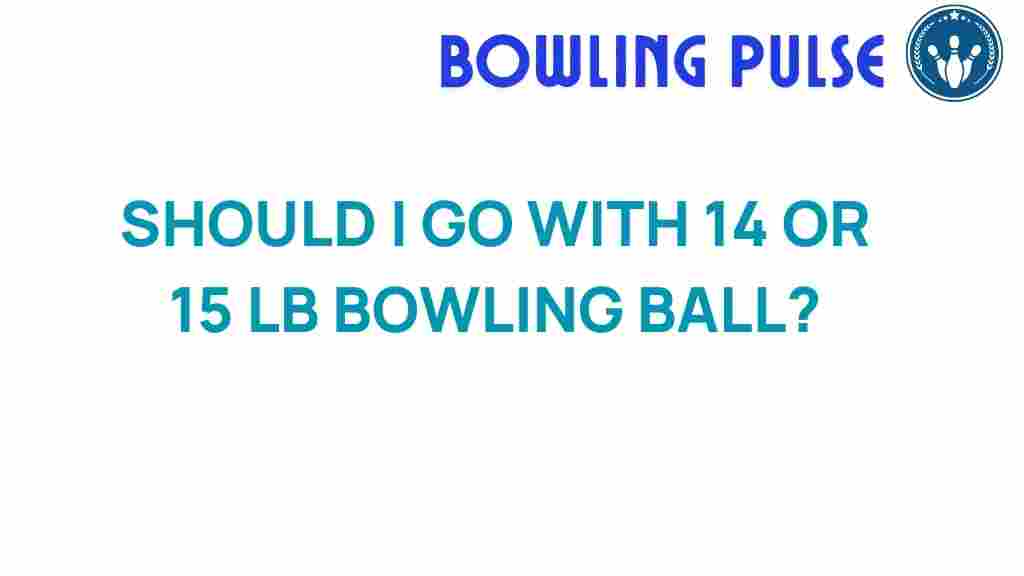The Great Debate: 14 lb or 15 lb Bowling Ball – Which Should You Choose?
Choosing the right bowling ball weight is crucial for both beginners and experienced bowlers alike. Among the various options available, the 14 lb bowling ball and the 15 lb bowling ball are two of the most popular choices. Each weight has its advantages and disadvantages, which can significantly impact your bowling performance. In this article, we will explore the differences between these two weights, provide valuable bowling tips, and help you make an informed equipment choice that suits your bowling technique.
Understanding Bowling Ball Weight
The weight of a bowling ball can dramatically affect your game. Bowling ball weight is typically measured in pounds, and it’s essential to select a weight that you can comfortably throw while maintaining accuracy and control. A heavier ball can knock down more pins, while a lighter ball may be easier to handle for some bowlers. Here’s a breakdown of what to consider when choosing between a 14 lb bowling ball and a 15 lb bowling ball:
1. Physical Strength and Comfort
Your physical strength plays a significant role in determining which bowling ball weight is best for you. Here are some factors to consider:
- Grip Strength: If you have strong grip strength, you may find that a 15 lb bowling ball is manageable for you. Conversely, if you struggle with grip strength, a 14 lb bowling ball may be more suitable.
- Endurance: Heavier balls can be more tiring to throw repeatedly. Consider how many games you plan to play in one session and choose a weight that allows you to maintain your performance.
- Comfort Level: A bowling ball should feel comfortable in your hand. Test out both weights to see which one you can control better without straining your arm or wrist.
2. Bowling Performance
Bowling performance is highly influenced by the weight of the ball. Here are some key points to keep in mind:
- Pin Action: A 15 lb bowling ball generally has more momentum and can create better pin action, leading to more strikes.
- Speed and Control: A 14 lb bowling ball may allow for better speed and control, especially for beginner bowlers who are still developing their technique.
- Hook Potential: Heavier balls may be more challenging to hook for some bowlers due to their weight, while lighter balls can be easier to spin.
Choosing the Right Bowling Ball Weight
When deciding between a 14 lb bowling ball and a 15 lb bowling ball, consider the following steps:
Step 1: Assess Your Skill Level
Beginner bowlers may find it easier to start with a 14 lb bowling ball as they develop their technique. More experienced bowlers might prefer the added weight of a 15 lb ball for increased power.
Step 2: Try Before You Buy
Visit your local bowling alley and try both weights. Pay attention to how each ball feels when you throw it, and take note of any differences in your accuracy and comfort level.
Step 3: Consider Your Style of Play
Your bowling technique can also influence your choice. If you prefer a slower, more controlled throw, a 14 lb ball might be better. If you have a powerful throw and can handle the extra weight, a 15 lb ball may work well for you.
Step 4: Consult With a Pro
If you’re still unsure, consider talking to a bowling coach or professional. They can provide personalized advice based on your specific needs and performance.
Bowling Tips for Choosing a Ball
To enhance your bowling experience, consider these essential tips:
- Experiment with Weights: Don’t hesitate to try different weights and brands to find what feels right for you.
- Focus on Technique: Regardless of the weight you choose, proper technique is vital for consistent performance. Practice your grip, stance, and release.
- Balance is Key: Ensure that the ball you choose is well-balanced for your style of play. A poorly balanced ball can affect your accuracy.
Troubleshooting Common Issues
Even with the right bowling ball weight, you might encounter issues that affect your performance. Here are some common problems and how to troubleshoot them:
1. Lack of Power
If you’re not generating enough power, consider switching to a heavier ball. However, ensure that you can still manage it comfortably to avoid injury.
2. Inconsistent Accuracy
Inconsistent accuracy can stem from poor technique rather than ball weight. Focus on your form, and consider practicing with a coach or mentor to improve your skills.
3. Fatigue During Play
If you find yourself getting tired quickly, it may be a sign that your ball is too heavy. Switching to a 14 lb bowling ball might help you maintain your performance over a longer period.
Conclusion
Choosing between a 14 lb bowling ball and a 15 lb bowling ball ultimately depends on your physical strength, skill level, and personal preference. Both weights have their pros and cons, and the right choice can enhance your bowling performance significantly. By assessing your needs, trying out different weights, and focusing on your bowling technique, you can make an informed decision that will improve your game.
Remember, the most important thing is to enjoy the game and feel comfortable with your equipment. Whether you choose a 14 lb bowling ball or a 15 lb bowling ball, the right choice is the one that feels best for you.
For more tips on improving your bowling skills, check out this comprehensive guide to bowling techniques. And if you’re looking for quality bowling equipment, visit Bowling.com for the latest gear.
This article is in the category Equipment and created by BowlingPulse Team
